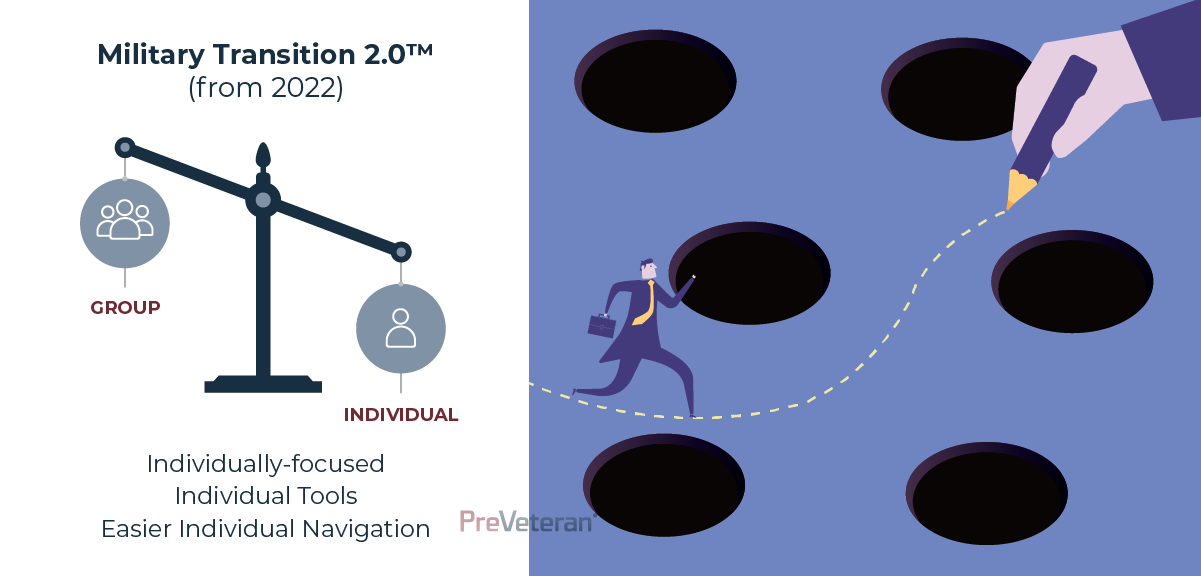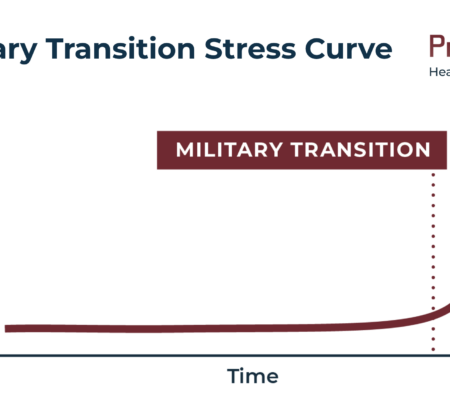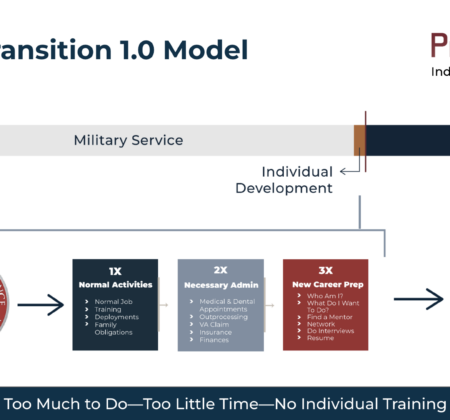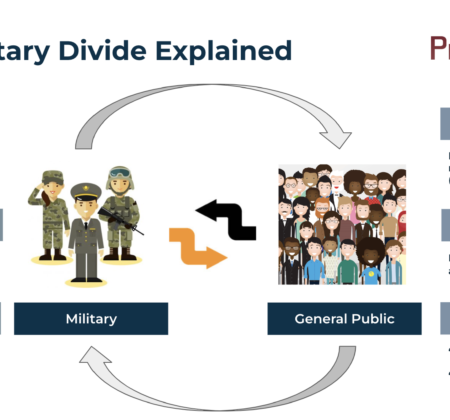- As we enter into our third and final article of the series, the problem has been clearly spelled out—there are two major root causes for why the two years following military transition are so problematic for transitioning military members: the group-focused Military Transition 1.0, with its secondary and tertiary markets and influencers all beating the same old inefficient drum, and how each military member and spouse tries to think through these group resources to find their individual way.
- In addition, we exposed you to two new concepts, the Brain Gap® and Military Mindset Heuristic® that will help better explain the behaviors emanating from the existing system.
- Now it’s time to talk about solutions to this enduring challenge, particularly in light of a system and stakeholders so institutionalized, there’s little chance it will change itself in a meaningful way.
- Our PreVeteran solution is something we call Military Transition 2.0, and, as you can see by the graphic, it encourages ALL transition programs to create individually focused programs, with individual tools, to create easier individual navigation through each member’s unique military transition journey
- Under our unique PreVeteran Military Transition 2.0 construct, the transitioning military member must do three things to be successful, no matter what they choose to do post-military. First, they have to change the way they think. Second, they have to begin aligning themselves to the private sector’s needs and wants. And finally, they need to perform and become proficient at these two actions BEFORE they take off the uniform.
- We also strongly recommend they perform and become proficient at the first two actions before they do ANY post-military program including: SkillBridge, getting a job, going to school using their GI Bill, or deciding to start a company.
- This is key. Not doing this will make every current Skillbridge, job, school, or business outcome less efficient because the individual has yet to change their mindset. In other words, a failure to change their mindset will be a real obstacle to their success.
- Let’s start with the need for changing the way they think—because while it’s 100% necessary, it’s also very tricky. First and foremost, as we discussed in article two of the series, they must change the way they think because they are leaving the < 1% of the U.S. population that serves in the active component and entering the 93% of the U.S. population that’s not veteran-affiliated and is operating in a different system than the military system. This 93% non-veteran-affiliated population will be their neighbors, teachers, employers, and community members.
- While necessary, this exercise is very tricky because it’s extremely challenging to get a grown adult to change their minds. Add to that a military identity, and you’ll find that convincing that transitioning military member (or military spouse) to challenge their own current line of thinking becomes almost impossible.
- You must have the right individual tools, used in the right order, that gives that transitioning member the space and reflection needed to reconsider their current thinking and then to decide, of their own volition, to change how they think.
- Once they decide for themselves that changing the way they think will benefit them and their families, they will be individually empowered and we’re off to the races where they quickly and confidently move toward post-military self-sufficiency.
- With this mindset shift underway, transitioning military members’ minds are also more open to understanding the private sector’s needs and wants—the second requirement for Military Transition 2.0.
- And here’s the best part: this can all be done BEFORE the military member takes off his or her uniform—the third requirement for Military Transition 2.0.
- How are we so sure of this? Well, at PreVeteran, we’ve been getting these results from our four Employment Prep Course cohorts we’ve run for the past year. Instead of hearing it from me, listen to a couple of our students talk about it in their own words.
- Which brings us to the end of our final article in this series, where we have a simple question we’d like to ask you.
- Whether you’re a transitioning military member, military spouse, or organization supporting their transition, are you happy with the current results from the Military Transition 1.0 system? If you are, we respect your opinion and there’s no need to read further.
- If, however, you’re not satisfied with the current Military Transition 1.0 system’s results and want something better—much better—we invite you to join this badly needed movement and become a Military Transition 2.0 partner.
- At the end of the day, whether you’re a transitioning military member, a military spouse, or an organization supporting these members, it’s time for a better solution.
- We all deserve better and the choice is ours to make.
Check Out Our PreVeteran Courses



